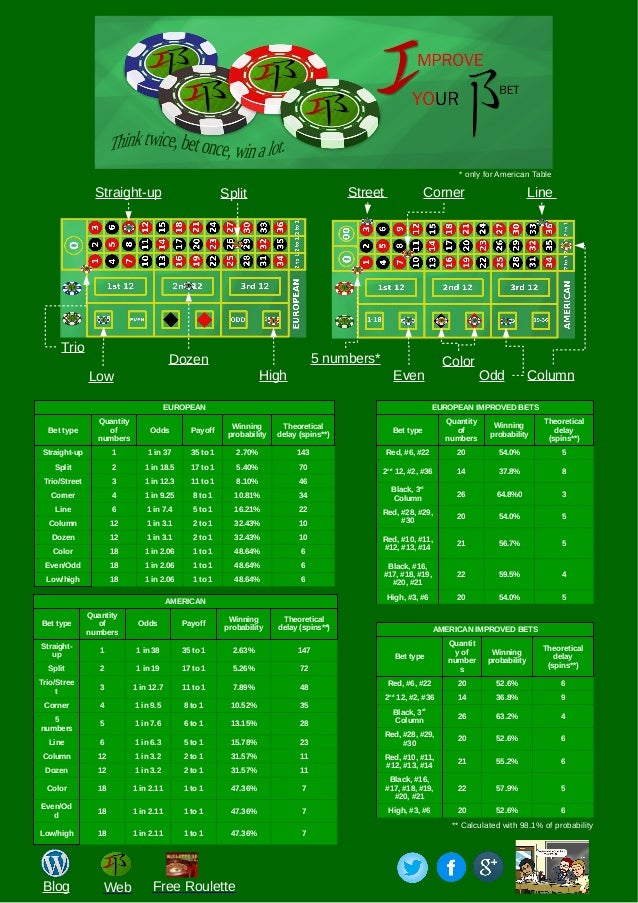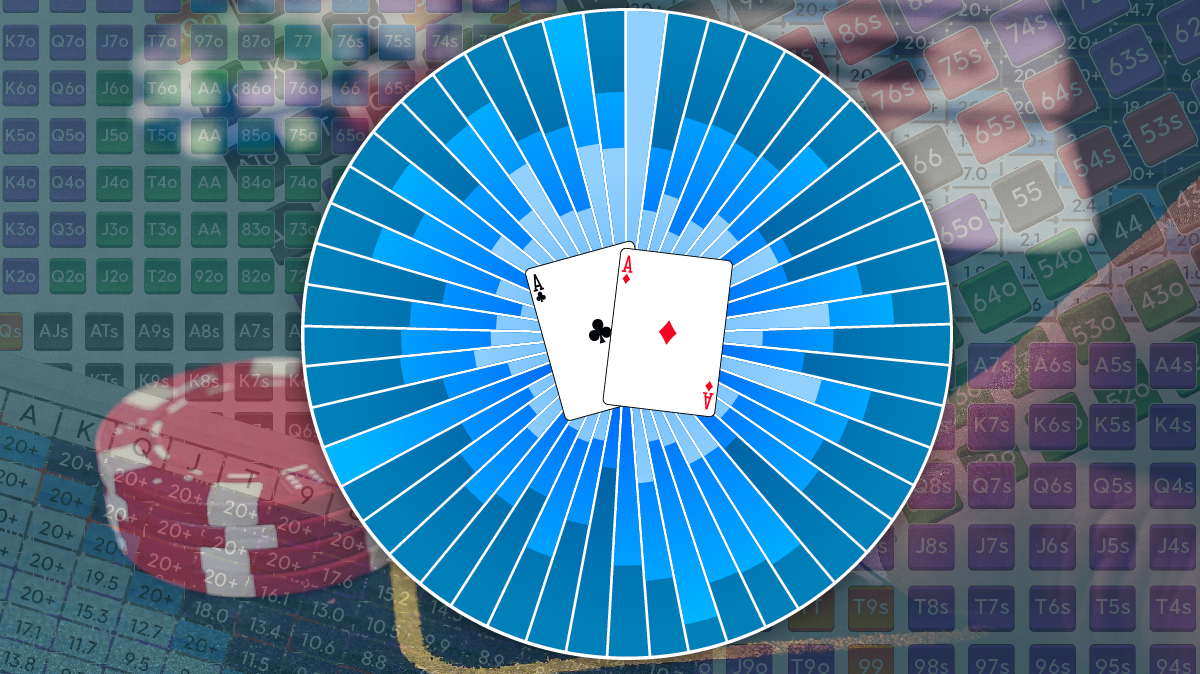In this article we define and publish the exact pre-flop probabilities for each possible combination of two hands in Textas Hold’em poker. An online tool at tools.timodenk.com/poker-odds-pre-flop makes the data visually accessible.
Table of Contents
Introduction
A deck of French playing cards, as it is used in Texas Hold’em, contains 52 different cards; in a heads-up game two players are playing against each other. Both of them get two private cards dealt pre-flop face down. There are $binom{52}{2}=1326$ different possible pairs of cards that players can get. In this work we determine the odds of each starting hand to win against any other starting hand. There is no equation or easy way of calculating the winning probability of a given hand, since it would be required to contain all the rules and mechanics of the game.
Statistical approaches can determine the winning odds of one starting hand against another very quickly. This gives results that are statistically accurate but not guaranteed to be exact. However, for mathematical analysis of certain properties of pre-flop situations, the precise numbers are a requirement.
Win Function
Heads up Poker Tournament Strategy covering hand selection, pot odds, reads, position and more. Heads Up Poker Strategy 492 Users Online Now. Here's a pot odds chart to keep in mind. Odds% You Hold Outs 2-to-1 32.00% A Pair 2 50-to-1 2.02% Two Pair 4 8-to-1 12.00% Inside Straight 4 400-to-1 0.25% Overcards 6 118-to-1 0.85% Open-ended Straight 8 9-to-1 10.90% Four Flush 9 15-to-1 6.50% Straight & Flush Draw Straight / Flush or Better 15 Three of a Kind. Nash tables are designed for heads-up play and give you perfect calling and shoving ranges when you are up against a single opponent. It should not be used for your pushing or calling decisions in a full table when everyone is folded to the small blind, but rather in an actual heads-up game where there are only two players at the table. Poker hand heads up odds Browse 20,993 poker stock illustrations and vector graphics available royalty-free, or search for poker chips or poker background to find more great stock images and vector art. Poker hand collection of 25 free cliparts and images with a transparent background. Download and use it for your personal or non-commercial.

Hold’em cards can have 13 different ranks and four different suits
$$begin{align}
mathcal{R}=&left{text{Ace}, text{2}, text{3}, text{4}, text{5}, text{6}, text{7}, text{8}, text{9}, text{10}, text{Jack}, text{Queen}, text{King}right},
mathcal{S}=&left{text{Club}, text{Heart}, text{Spade}, text{Diamond}right},.end{align}$$A card is an ordered pair of rank and suit; the set of all cards that exist in a the card deck is denoted as
$$begin{align}mathcal{C}=mathcal{R}timesmathcal{S},end{align}$$ with $leftlvertmathcal{C}rightrvert=52$. The set of possible starting hands, every possible combination of two distinct cards, is defined by
$$begin{align}mathcal{H}=left{left{c_1inmathcal{C},c_2inmathcal{C}right}mid c_1neq c_2right}end{align}$$ and has a cardinality of $lvertmathcal{H}rvert=binom{52}{2}=1326$. The set is containing unordered pairs because the two private cards are not ordered either.
Calculating the Cartesian product of the set of possible hands with itself gives a new set of ordered pairs, that is $mathcal{M}=mathcal{H}timesmathcal{H}$, with $leftlvertmathcal{M}rightrvert=1,758,276$. This set contains all combinations of two starting hands as ordered pairs. The order matters, because we define the meaning of each of the pairs as a pre-flop situation where the first starting hand plays against the second.

In this work we search for the winning odds function
$$begin{align}
o:mathcal{M}rightarrowleft{xinmathbb{Q}mid0le xle1right},
end{align}$$ that outputs for any pre-flop situation $left(h_1,h_2right)$, the odds of starting hand $h_1$ to win against $h_2$. Since every card exists only once in a deck, two players cannot play against each other if $h_1cap h_2neemptyset$. For these cases $o$ is undefined.
Post-flop, five community cards are dealt. Three on the flop, followed by the turn card, and finally the river card. $binom{52}{5}=2598960$ different combinations are possible. We define $mathcal{P}$ as the set of all possible community cards, where each $pinmathcal{P}$ is itself a set of five different cards. The community cards $p$ determine which player wins, that is the one whose starting hand builds the best showdown hand. If both showdown hands are of equal rank at showdown, the pot is split. Given a pre-flop situation $m=(h_1,h_2)$ where the starting hand $h_1$ plays against $h_2$, only a subset of $mathcal{P}$, namely $$begin{align}mathcal{P}_{(h_1,h_2)}=left{pinmathcal{P}mid pcap h_1=pcap h_2=emptysetright}end{align}$$ can be dealt, as some cards are already taken from the deck.
Furthermore a win function
$$begin{align}w:{(minmathcal{M},pinmathcal{P}_m)}rightarrow{0,1}end{align}$$is required, that assesses a situation at showdown and returns $1$, if the first starting hand in $m$ wins against the second hand, given the public cards $p$. In case of loss or split it returns $0$. $w$ is defined by the rules of poker. With these definitions at hand we can define the odds of a hand to win against another hand as
$$begin{align}o(m)=frac{displaystylesum_{pinmathcal{P}_m}w(m,p)}{lvert mathcal{P}_mrvert},.end{align}$$In words, $o$ is dividing the number of possible community cards where $h_1$ wins against $h_2$ by the number of community cards that can be dealt altogether.
Data and Results
With the odds function $o$ at hand, we can define the winning odds matrix $mathbf{M}inmathbb{Q}^{lvertmathcal{H}rverttimeslvertmathcal{H}rvert}$ as
$$M_{i,j}=o(mathcal{H}_i,mathcal{H}_j),.$$ The matrix contains the winning odds for every heads-up pre-flop situation and is undefined at places, where $mathcal{H}_i$ and $mathcal{H}_j$ cannot play against each other (because of shared cards). From its row vectors, i.e. $mathbf{M}_{i,:}$, we can compute the average odds of a hand $mathcal{H}_i$ to win against a random hand, by taking the average of all entries with values. The probabilities for a split between two hands are given by $1-M_{i,j}-M_{j,i}$.
We release $mathbf{M}$ in two ways.
- As an online tool with user interface at tools.timodenk.com where the user can pick their pre-flop situation and get the exact odds, i.e. $o(m)$ and $o(m)lvertmathcal{P}_mrvert$.
- As a serialized Java object holding the $o(m)lvertmathcal{P}_mrvert$ values for every $m$. The object can be imported into a Java program and processed from there.
We have already conducted some experiments related to the non-transitivity of the win function. For example, we found the three hands
$$begin{align}
h_1=&left{left(text{Ace},text{Club}right),left(text{2},text{Club}right)right}
h_2=&left{left(text{10},text{Spade}right),left(text{9},text{Spade}right)right}
h_3=&left{left(text{2},text{Heart}right),left(text{2},text{Diamond}right)right},
end{align}$$to satisfy$$begin{align}
oleft(h_1,h_2right)approx&0.54gt0.5
oleft(h_2,h_3right)approx&0.53gt0.5
oleft(h_3,h_1right)approx&0.61gt0.5,.
end{align}$$Expressed in words, this means for a hand $h_1$, which statistically beats $h_2$, which in turn beats a third hand $h_3$, it cannot be concluded that $h_1$ beats $h_3$ as well. The win function is not transitive.

The most uneven pre-flop situation exists, if the hands$$begin{align}
h_1=&left{left(text{King},text{Club}right),left(text{King},text{Diamond}right)right}
h_2=&left{left(text{King},text{Heart}right),left(text{2},text{Club}right)right}
end{align}$$play against each other (or suit permutations). The pair of kings has a $94.16%$ chance of winning. The pot is chopped in $1.53%$ of all possible outcomes.
Surprisingly, Aces do not appear in this constellation. The reason is that the hand A2 could hit a straight with just three cards (3, 4, 5). On the other hand, K2 needs four cards (A, 3, 4, 5 or 3, 4, 5, 6) in order to build a straight that uses the 2. Also noteworthy is the fact, that the King of Clubs of $h_1$ blocks flushes, which $h_2$ could have otherwise gotten using the Deuce of Clubs.
The lowest winning probability and highest probability for a split pot exists if $$begin{align}
h_1=&left{left(text{3},text{Club}right),left(text{2},text{Diamond}right)right}
h_2=&left{left(text{3},text{Diamond}right),left(text{2},text{Club}right)right}
end{align}$$battle each other. Both hands have an equal chance of winning, namely $0.71%$. Consequently, a split occurs with a likelihood of $98.57%$.
Interestingly, the get-together of 43 vs. 43 (same suits as above) comes with a higher winning probability ($0.73%$). That’s (at least partly) because there are a few more flushes, for which one of the hands does not only play the board.
Draw Poker Odds Chart
The lowest split probability of just $0.19%$ is there, if the following hands play:$$begin{align}
h_1=&left{left(text{9},text{Club}right),left(text{8},text{Diamond}right)right}
h_2=&left{left(text{Ace},text{Spade}right),left(text{Ace},text{Heart}right)right},.
end{align}$$In which cases would the pot be chopped? For instance if a straight flush of Clubs from 2 to 6 occurs.
Poker Odds Chart Pdf
Still unsolved is the search for the longest non-transitive chain of mutually disjoint pre-flop hands, such that $$o(h_1, h_2)>0.5land o(h_2,h_3)>0.5landdotsland o(h_n,h_1)>0.5,.$$
Poker Hand Odds Chart
Special thanks goes to Dominik Müller for fruitful discussions and many algorithm optimization ideas.